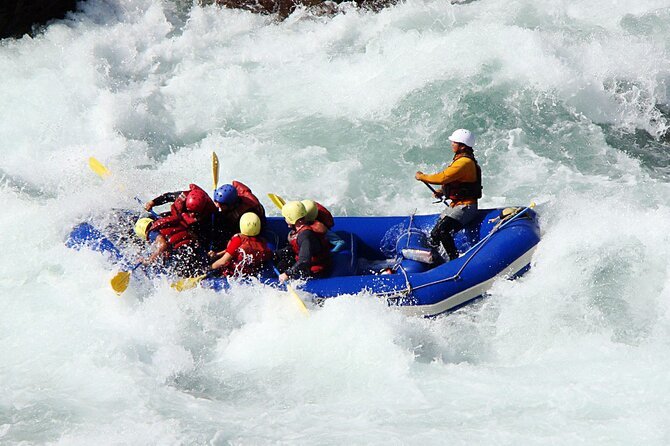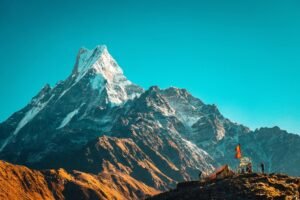The Himalayas, the world’s highest mountain range, stretch across five countries and offer an unparalleled adventure playground for thrill-seekers and nature enthusiasts. This vast and rugged terrain is not only known for its towering peaks and stunning landscapes but also for its exciting array of adventure sports. Among these, paragliding and white water rafting stand out as two of the most exhilarating activities. In this comprehensive guide, we will explore the ins and outs of these sports, along with other thrilling Himalayan adventures that beckon travelers from around the world.
1. Paragliding in the Himalayas
Overview
Paragliding, a sport that allows participants to soar through the air with a parachute-like wing, offers an unparalleled way to experience the breathtaking beauty of the Himalayas. The sport has gained popularity in the region due to its ability to provide both an adrenaline rush and a peaceful connection with the natural world. The diverse terrains of the Himalayas create ideal conditions for paragliding, with various take-off points providing stunning views and unique flying experiences.
Popular Paragliding Destinations
1.1. Bir Billing, Himachal Pradesh
Bir Billing, a small village in Himachal Pradesh, has become synonymous with paragliding in India. The take-off point, Billing, is situated at an altitude of around 2400 meters, offering optimal conditions for an exhilarating flight. The site benefits from strong and consistent thermals, which allow for long and smooth flights. Bir Billing is renowned for its annual Paragliding World Cup, which attracts pilots from all corners of the globe. The landing area in Bir is surrounded by lush green fields and offers a picturesque setting to conclude your flight.
1.2. Manali, Himachal Pradesh
Manali, a popular hill station in Himachal Pradesh, offers a range of paragliding experiences. The take-off sites, such as Solang Valley, are located at altitudes of around 2000 meters, providing excellent views of the snow-capped peaks of the Himalayas. The area is known for its variable flying conditions, which can range from gentle and smooth to turbulent and challenging, catering to both novice and experienced pilots. The panoramic views of the Kullu Valley and the surrounding mountains make every flight a memorable experience.
1.3. Nainital, Uttarakhand
Nainital, known for its scenic beauty and serene lake, also offers thrilling paragliding opportunities. The take-off site at Kunjkharak, located above the town, provides stunning aerial views of the Naini Lake and the lush green hills surrounding it. The relatively calm air and gentle slopes make it an ideal location for beginners who are looking to experience the thrill of paragliding for the first time. Nainital’s unique charm and tranquil environment enhance the overall paragliding experience.
1.4. Bir-Billing Adventure Festival
The Bir-Billing Adventure Festival is a notable event that brings together paragliding enthusiasts and adventure seekers from around the world. Held annually in Bir Billing, this festival showcases a variety of paragliding events, including cross-country races and aerobatic displays. The festival provides an opportunity for participants to experience the best of Bir Billing’s flying conditions and to connect with fellow adventure enthusiasts.
What to Expect
During a paragliding session, you will typically be harnessed to an experienced pilot if you are a beginner. Tandem flights are common, allowing you to enjoy the experience without extensive training. The flight usually lasts between 15 to 30 minutes, depending on weather conditions and the specific site. As you soar through the air, you will experience a sense of freedom and tranquility, combined with the thrill of flying above some of the most stunning landscapes on Earth.
The pre-flight briefing is crucial and covers safety procedures, take-off and landing techniques, and what to expect during the flight. You will also be provided with safety equipment, including a helmet and harness, to ensure a secure and enjoyable experience.
Safety and Regulations
Safety is paramount in paragliding, particularly in the challenging terrains of the Himalayas. Reputable operators ensure that their equipment is well-maintained and that pilots are highly trained. It is essential to follow the safety instructions provided by your pilot and to be aware of weather conditions, as high winds and sudden changes in weather can impact your flight.
Before embarking on a paragliding adventure, check the credentials of your operator and ensure they adhere to local safety regulations. It is also advisable to have travel insurance that covers adventure sports.
2. White Water Rafting in the Himalayas
Overview
White water rafting is an exhilarating sport that allows you to navigate turbulent river rapids using an inflatable raft. The Himalayas are home to some of the most challenging and scenic rivers, making it an ideal destination for rafting enthusiasts. The rivers in this region offer a range of rapids, from gentle stretches to intense Class IV and V rapids, catering to various skill levels.
Popular Rafting Destinations
2.1. Rishikesh, Uttarakhand
Rishikesh, often considered the rafting capital of India, offers a plethora of rafting experiences on the Ganges River. The river’s rapids range from gentle Class I and II to thrilling Class III and IV sections. Rafting in Rishikesh provides not only an adrenaline rush but also a chance to experience the spiritual and cultural atmosphere of the town. The scenic beauty of the river valley, combined with the opportunity to spot wildlife and enjoy a riverside camp, makes it a popular choice for adventure seekers.
2.2. Manali, Himachal Pradesh
The Beas River in Manali is another prime location for white water rafting. The river features a variety of rapids, offering a mix of thrilling sections and calmer stretches. Rafting trips on the Beas River provide stunning views of the Kullu Valley and the surrounding mountains, enhancing the overall experience. The area also offers options for multi-day rafting expeditions, allowing you to explore more remote sections of the river.
2.3. Zanskar, Ladakh
For those seeking a more remote and challenging rafting experience, the Zanskar River in Ladakh is an excellent choice. The river flows through a dramatic canyon and features Class IV and V rapids, making it suitable for experienced rafters. The high-altitude environment and unique landscapes of Ladakh add to the adventure, offering a rare and exhilarating rafting experience. The trip usually includes camping by the river, providing a chance to immerse yourself in the rugged beauty of the region.
2.4. Tista River, Sikkim
The Tista River in Sikkim is known for its pristine environment and challenging rapids. Rafting on the Tista offers an opportunity to experience the diverse landscapes of Sikkim, from lush forests to rugged gorges. The river’s rapids range from Class III to Class IV, providing a thrilling ride through some of the most beautiful and remote areas of the region.
What to Expect
A typical white water rafting trip begins with a safety briefing and equipment fitting. You will be provided with a life jacket, helmet, and paddle, and given instructions on paddling techniques and safety protocols. The rafting experience includes navigating through rapids, calm stretches, and sometimes even jumping into the river for a refreshing swim.
Rafting trips can vary in length, from a few hours to a full day or more, depending on the chosen route and river conditions. The experience combines the excitement of navigating rapids with the beauty of the river’s surroundings.
Safety and Regulations
Safety is a top priority in white water rafting. Reputable operators provide well-maintained equipment and ensure that guides are trained to handle emergencies. It is important to listen to safety instructions and follow guidelines to ensure a safe and enjoyable experience.
Before embarking on a rafting trip, check the safety standards of the operator and ensure they have the necessary permits and insurance. It is also advisable to have travel insurance that covers adventure sports.
3. Trekking and Mountaineering
Overview
The Himalayas are renowned for their trekking and mountaineering opportunities. The region offers a range of trekking routes, from moderate hikes to challenging expeditions, each providing unique experiences and breathtaking views. Mountaineering in the Himalayas is a prestigious pursuit, with some of the world’s highest peaks attracting climbers seeking to test their skills and endurance.
Popular Trekking Routes
3.1. Everest Base Camp Trek
The Everest Base Camp Trek is one of the most iconic and sought-after treks in the world. The trek takes you through the Khumbu region of Nepal, providing stunning views of Mount Everest, Lhotse, and other towering peaks. The journey includes crossing high-altitude passes, visiting traditional Sherpa villages, and exploring the vibrant culture of the region. The trek typically takes around 12 to 16 days, allowing time for acclimatization and exploration.
3.2. Annapurna Circuit
The Annapurna Circuit is renowned for its diverse landscapes, ranging from subtropical forests to high-altitude deserts. The trek takes you around the Annapurna massif, providing panoramic views of Annapurna, Dhaulagiri, and Machapuchare. The circuit also offers a cultural experience as you pass through traditional Nepalese villages and interact with local communities. The trek usually takes around 15 to 20 days, depending on the chosen route and pace.
3.3. Markha Valley Trek
Located in Ladakh, the Markha Valley Trek is a remote and less-traveled route that offers stunning desert landscapes, high mountain passes, and ancient monasteries. The trek provides a chance to experience the unique culture and environment of Ladakh, with its stark contrasts between arid terrain and lush green valleys. The trek typically takes around 10 to 15 days, allowing time to explore the diverse landscapes and cultural sites.
3.4. Roopkund Trek
The Roopkund Trek, also known as the Skeleton Lake Trek, is a high-altitude trek in Uttarakhand that leads to a glacial lake known for the skeletal remains found in its vicinity. The trek offers breathtaking views of the Himalayas, including Nanda Ghunti and Trishul, and takes you through diverse terrains, from lush forests to alpine meadows. The trek usually takes around 8 to 10 days and provides an intriguing mix of natural beauty and historical mystery.
Safety and Regulations
Trekking in the Himalayas requires careful planning and preparation. It is essential to acclimatize properly to avoid altitude sickness and to be prepared for changing weather conditions. Hiring a reputable guide or joining an organized trekking group can enhance safety and ensure a smooth experience.
Before embarking on a trek, obtain the necessary permits and check the regulations for your chosen route. Ensure that your guide or trekking operator adheres to safety standards and has experience in managing high-altitude treks.
4. Other Adventure Sports
Mountain Biking
Mountain biking in the Himalayas offers an exhilarating way to explore the region’s rugged terrain. Popular routes include the Manali to Leh highway and the Shimla to Manali stretch. These routes provide challenging climbs, thrilling descents, and stunning vistas. The high-altitude environment and varied terrain make mountain biking a unique and adventurous way to experience the Himalayas.
4.1. Manali to Leh
The Manali to Leh route is a renowned mountain biking adventure that takes you through some of the most breathtaking landscapes in the Himalayas. The route includes high mountain passes, including the famous Rohtang Pass and Tanglang La, and offers stunning views of the rugged terrain and remote villages. The journey typically takes around 10 to 15 days, depending on your pace and the weather conditions.
4.2. Shimla to Manali
The Shimla to Manali stretch is another popular mountain biking route that offers a mix of challenging climbs and exhilarating descents. The route passes through scenic valleys, dense forests, and charming villages, providing a diverse biking experience. The journey usually takes around 7 to 10 days, allowing time to explore the beautiful landscapes and local culture.
Rock Climbing
The Himalayas also offer excellent rock climbing opportunities, with established climbing routes catering to various skill levels. Areas such as Manali and Rishikesh have become popular destinations for rock climbing enthusiasts, with a range of routes and challenges to suit different abilities.
4.1. Manali
Manali’s rocky cliffs and boulders provide a variety of climbing opportunities. The area has established climbing routes, ranging from beginner-friendly to advanced. The stunning views of the surrounding mountains add to the thrill of climbing in this picturesque setting.
4.2. Rishikesh
Rishikesh is known for its diverse range of adventure activities, including rock climbing. The area offers a variety of climbing routes, from easy climbs to more challenging ascents. The unique combination of natural beauty and adventure makes rock climbing in Rishikesh a memorable experience.
Skiing and Snowboarding
During the winter months, the Himalayas transform into a skiing and snowboarding paradise. Resorts such as Gulmarg in Jammu and Kashmir and Auli in Uttarakhand offer powder-filled slopes and breathtaking views.
4.1. Gulmarg
Gulmarg, located in Jammu and Kashmir, is renowned for its excellent skiing and snowboarding conditions. The area receives heavy snowfall during the winter season, providing ample opportunities for powder skiing and off-piste adventures. The views of the surrounding mountains and the pristine snow create a magical winter experience.
4.2. Auli
Auli, situated in Uttarakhand, is another popular destination for skiing and snowboarding. The area offers well-groomed slopes and stunning views of the Nanda Devi and other peaks. Auli is known for its family-friendly atmosphere and provides a range of skiing options for all skill levels.
The Himalayas offer a diverse range of adventure sports, each providing a unique way to experience the region’s stunning landscapes and challenging terrains. From the serene experience of paragliding to the adrenaline rush of white water rafting, and the thrill of trekking and mountaineering, there is something for every adventure enthusiast. The Himalayas’ combination of natural beauty, cultural richness, and exhilarating activities makes it a premier destination for those seeking unforgettable adventures.
As you plan your Himalayan adventure, remember to prioritize safety, choose reputable operators, and respect the environment. With careful preparation and a spirit of adventure, you can make the most of the breathtaking landscapes and exciting challenges that this majestic mountain range has to offer.





